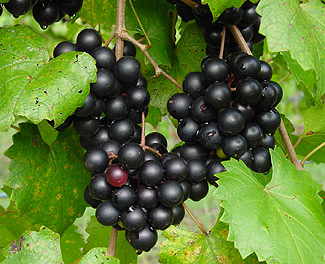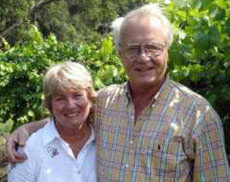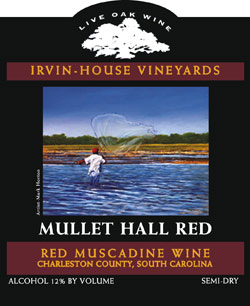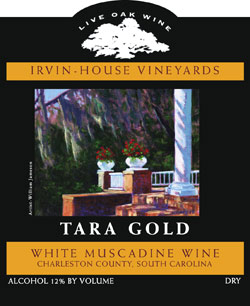

Irvin-House Vineyards found a way to transform the ordinarily sweet Muscadine into a dry wine more appropriate to pair with food.
South Carolina (State Appellation)
A (Not-So-Sweet) Story of Success
with South Carolina Muscadine
Irvin-House Vineyards on Wadmalaw Island dries out the scuppernong for the restaurant trade, enters the spirits market with Firefly Muscadine vodka, and touts the health benefits of both.
by
Gregory McCluney
July 30, 2008
 ith a marketing slogan of “Live Oak Wine” and labels such as Palmetto, Mullet Hall Red, Live Oak Reserve, Magnolia and Tara Gold, a wine drinker might suspect some form of Scuppernong (Muscadine) as the primary grape. But when you have a vineyard and winery on subtropical Wadmalaw Island, South Carolina, it’s the only grape.
ith a marketing slogan of “Live Oak Wine” and labels such as Palmetto, Mullet Hall Red, Live Oak Reserve, Magnolia and Tara Gold, a wine drinker might suspect some form of Scuppernong (Muscadine) as the primary grape. But when you have a vineyard and winery on subtropical Wadmalaw Island, South Carolina, it’s the only grape.
Jim and Ann Irvin (before marrying Jim, her name was House hence the name Irvin-House Vineyards) bought their vineyard land

Jim and Anne Irvin
Irvin secured the services of consultant Thomas Payette, a Virginia winemaker, who specializes in helping eastern winemaking and vineyard ventures based on his 20 years of experience in Virginia. And Irvin credits his quick success to this experience.
Other consultants predicted it would be four years before they could make wine, but it was actually only two years until their first harvest from this robust variety. Then two years later, in 2004, their yield from the same vines almost doubled. They decided from the beginning to avoid spraying for pesticides and chemical treatments. This tough variety has an extra chromosome, which renders it disease resistant and immune to fungus.
The Southern tradition of making wine from this most prolific of all American grapes began in 1554 in the Sir Walter Raleigh colony. Because of its incredible ability to survive and resist any disease, the colonists named it the “Grape of
 Grapes” and “the South’s own Grape.” By many reports, this incredible vine is still bearing fruit 350 years later! Scuppernong was a Native American name (from the Askupo) originally given to the white variety, but in fact, they are all Species Vitis Rotundiofolia, commonly called Muscadine. To further the confusion, many dark Muscadines were called “Bull Grape” or “Bullis” because of their resemblance to the European plum of the same name.
Grapes” and “the South’s own Grape.” By many reports, this incredible vine is still bearing fruit 350 years later! Scuppernong was a Native American name (from the Askupo) originally given to the white variety, but in fact, they are all Species Vitis Rotundiofolia, commonly called Muscadine. To further the confusion, many dark Muscadines were called “Bull Grape” or “Bullis” because of their resemblance to the European plum of the same name.
“Believe it or not, we do irrigate, although this area receives 55 inches of rain a year,” Jim Irvin said. “In the first couple of years, they (the grapes) need 36 gallons of water per week.”
After that, too much water can be the problem. At times, he has had to pump out the vineyards after tropical storms. But not to worry about Pierce’s disease, points out Irvin, as Muscadine is naturally resistant.
“We have our biggest challenge at harvest, which just happens to come during South Carolina’s prime hurricane season,” Irvin said.
From the beginning, it was Irvin’s goal to take this grape beyond the traditional sweet wines commonly made in the South and sell it for pairing with food, not just as an aperitif or cocktail. Their vision was a “New Southern” wine that would be much drier and food friendlier. The Irvins wanted to see their wines on restaurant wine lists and on shelves with popular American vines. And people are catching on. Irvin-House is now sold by dozens of retailers and restaurants, primarily in South Carolina. The most popular in the tasting room are still the sweeter labels, but, in restaurants, the dry Mullet Hall Red and white Tara Gold are the winners.
The World’s Healthiest Wine?
The general health benefits of daily wine drinking have been widely publicized in recent years, but the benefits of Muscadine wine drinking are still largely unknown to most consumers, or even wine enthusiasts. The National Institute of Health, which has studied the Muscadine grape, found that it contains seven times the reseveratrol (the acclaimed antioxidant) of any other grape variety. Irvin refers health inquiries to Dr. Diane Hartle, who manages a nutraceutical research lab in Athens, Georgia (the home of the University of Georgia).
Health, which has studied the Muscadine grape, found that it contains seven times the reseveratrol (the acclaimed antioxidant) of any other grape variety. Irvin refers health inquiries to Dr. Diane Hartle, who manages a nutraceutical research lab in Athens, Georgia (the home of the University of Georgia).
Dr. Hartle trains graduate students in projects related to natural products and health, and has written a book, Muscadine Medicine . This book reveals data on how and why grape phytochemicals improve heart health, circulation, and how they may further benefit those concerned about such diverse medical aliments as asthma, cancer, diabetes, even obesity. The data is so convincing, it makes one want to start drinking Muscadine, sweet, dry or anywhere in between.
And Now, Muscadine Vodka?
While looking for a distributor for his wines, Jim Irvin met Scott Newitt at Republic National in Charleston. He told Irvin, “You make a nice Southern wine; now let’s make a Southern spirit,” and became a partner in Firefly Vodka. The still is now housed at the winery, although that took (literally) an act of the state legislature, who voted in favor of Firefly and reduced the license from $50,000 to $1,000 to get the business going. The first product was perfect for the South, Firefly Sweet Tea Vodka, and it is now the number one selling flavored vodka in South Carolina. But it is catching on in other states, too, and is currently available in New York, Colorado and Nevada. Another label, Firefly Muscadine Vodka, has been rolled out, and there’s more to come: Firefly Peach Vodka, Firefly Hand Crafted Vodka and Firefly Coffee Vodka. All, of course, are made from the Irvin-House Muscadine grapes grown on the island. Irvin feels strongly that there is a market and future for South Carolina wines. He is so convinced of this that, in early 2005, he formed the South Carolina Winery Association to promote the industry, and wine tourism to the area. With historic Charleston just 25 minutes away, that sounds like a natural.
Irvin feels strongly that there is a market and future for South Carolina wines. He is so convinced of this that, in early 2005, he formed the South Carolina Winery Association to promote the industry, and wine tourism to the area. With historic Charleston just 25 minutes away, that sounds like a natural.
Photos courtesy of Irvin-House










 READER FEEDBACK: To post your comments on this story,
READER FEEDBACK: To post your comments on this story,


